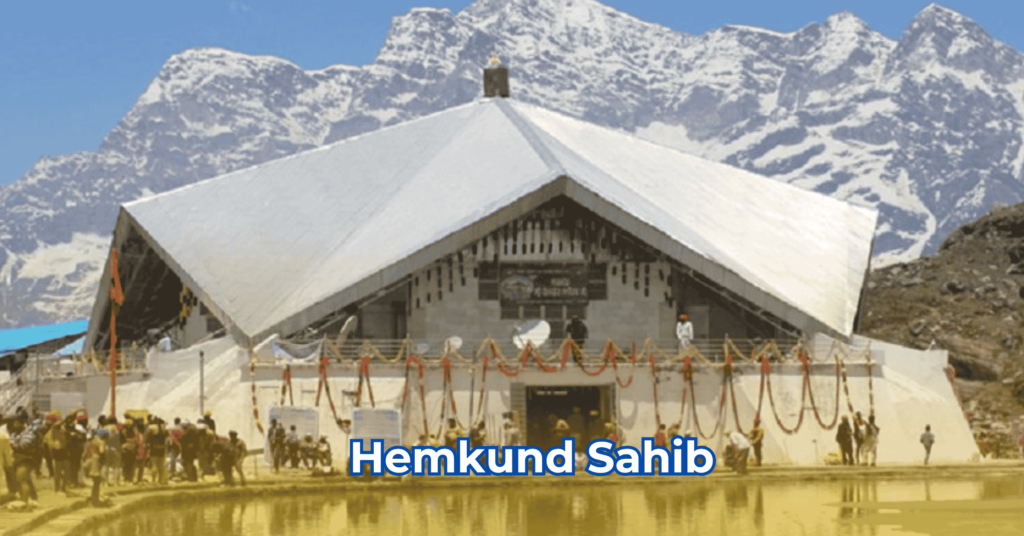Nestled high in the Garhwal Himalayas at 14,200 feet, Hemkunt Sahib Gurdwara isn’t just a place of worship—it’s a powerful, living testament to Sikh faith and devotion. For centuries, this sacred spot has drawn pilgrims who brave the difficult trek to pay homage and to connect deeply with the roots of Sikhism. The Hemkunt Sahib Yatra is much more than a journey through breathtaking mountains; it’s a spiritual passage that challenges you physically, strengthens your soul, and reminds you of the values of perseverance, service, and selflessness.
This Gurdwara is one of the highest pilgrimage sites in the world. What makes Hemkunt Sahib unique is its elevation and profound connection to Guru Gobind Singh Ji, the tenth Guru of Sikhism. Here, nestled among the towering snow-covered peaks, Guru Gobind Singh Ji is believed to have meditated in his previous life. The Gurdwara, set beside a crystal-clear lake, marks the place where the Guru, in his earlier incarnation, found solace and spiritual strength. Today, Hemkunt Sahib stands as a symbol of the Guru’s enduring message of faith, service, and determination.
The Historical Significance of Hemkunt Sahib
Hemkunt Sahib has a story that transcends centuries. Sikh tradition holds that Guru Gobind Singh Ji, before his incarnation as the tenth Guru, meditated in this very spot, known as Hemkunt or “Lake of Snow.” According to Sikh legend, Guru Gobind Singh Ji spent time in these mountains, surrounded by solitude and nature, contemplating his spiritual mission.
After years of searching, Bhai Vir Singh, a prominent Sikh scholar and writer, rediscovered the location of Hemkunt Sahib in 1930. A small Gurdwara was established at the site in the mid-20th century, but the connection to Guru Gobind Singh Ji’s earlier life and meditative practices has always remained central to the significance of this holy site.
Recommended: Tour & Travel Company In India
This is what makes Hemkunt Sahib more than just a place of pilgrimage. It’s a reminder that faith isn’t just about worshiping in comfort; it’s about embracing hardship, struggle, and devotion. To reach Hemkunt Sahib, pilgrims must endure a physically demanding trek, and in doing so, they echo the very spirit of what this Gurdwara stands for: the ability to overcome life’s challenges with unwavering faith.
The Trek: A Spiritual Journey
Most pilgrims start their journey to Hemkunt Sahib at Govind Ghat, a small town along the Alaknanda River. From here, the 19-kilometer trek winds through rugged terrain, alpine meadows, thick forests, and streams. This is not an easy journey. The path is steep and often slippery, especially as you climb higher into the mountains. It can take 6 to 7 hours of walking each day, and the altitude makes every step more challenging.
Along the way, you’ll pass by small langars (community kitchens) set up by local volunteers, where food and rest are offered to pilgrims free of charge. Langar is a cornerstone of Sikhism—it’s about offering service and sharing what you have with others. The simplicity of the food served without any expectations or distinction echoes the central tenets of Sikhism: equality, selflessness, and humility. As you rest and share meals with fellow pilgrims—often from different walks of life, from across India and beyond—you’ll feel a sense of community and connection that can be both humbling and inspiring.
Check out our spiritual tour packages for Hemkunt Sahib and other sacred destinations.
The trek is physically demanding but incredibly rewarding. As you ascend, you’ll notice the air becoming thinner, and your breath heavier. The higher you climb, the more you realize that the journey itself mirrors the spiritual path: difficult, but deeply meaningful. Every step you take, every moment of exhaustion, and every challenge face on the way up is a reminder that true spiritual progress is not easy. It requires determination, perseverance, and the willingness to continue, no matter the obstacles.
Arriving at Hemkunt Sahib Gurdwara
After hours of trekking through forests and meadows, you’ll finally arrive at Hemkunt Sahib, nestled at the foot of towering snow-covered peaks. The sight is breathtaking: a peaceful lake reflecting the surrounding mountains, with the Gurdwara itself standing as a humble symbol of devotion and faith.
The simplicity of the Gurdwara’s architecture is striking. There’s no grandiose design, no embellishment—just a clean, white structure sitting quietly beside the lake. This simplicity mirrors the spirit of Sikhism itself: faith is not about outward display, but about inward devotion and humility. Inside, you’ll find the Guru Granth Sahib, the Sikh holy book, placed in the center, surrounded by a community of people who have come here to seek blessings, to reflect, and to connect with the Guru’s teachings.
The Hemkunt Lake itself is sacred. Pilgrims often take a moment to sit by its shores, looking at the reflection of the peaks in the crystal-clear waters. Some say the lake’s stillness represents the calmness of the mind after a long and challenging journey. It’s a time for reflection, gratitude, and prayer. As you sit there, you’ll find that the surrounding natural beauty—the towering mountains, the clear sky, the fresh air—feels almost like a physical manifestation of the Guru’s teachings, reminding you that faith requires sacrifice, but the reward is a deeper connection to the divine.
Why Hemkunt Sahib Is Unique
What makes Hemkunt Sahib so special isn’t just its location or the struggle it takes to get there. It’s the profound connection to Guru Gobind Singh Ji’s life. Hemkunt Sahib represents a powerful moment in Sikh history, a moment of solitude, devotion, and deep spiritual connection.
It also reflects the very essence of Sikhism: selfless service, humility, equality, and perseverance. Here, where the challenges of the body meet the call of the soul, the teachings of Sikhism come alive in the most real, human way.
The trek to Hemkunt Sahib is not about luxury or comfort; it’s about connecting with the divine through the effort, struggle, and dedication of your journey. Every step you take, every person you meet, and every moment of difficulty you face on the way up is part of a much larger story of faith. And when you finally arrive at the Gurdwara, you’ll realize that the true reward wasn’t just reaching the top but in the faith you found along the way.
If you’re looking to experience a journey that goes beyond the ordinary, where history, spirituality, and adventure come together, Hemkunt Sahib is waiting for you. With Nihal Yatra, you can explore this sacred destination with ease, as we provide spiritual tour packages that make the pilgrimage to Hemkunt Sahib an unforgettable experience. Come, walk the path of devotion, and experience the sacredness of Hemkunt Sahib firsthand.
When Is the Best Time to Visit Hemkunt Sahib?
The best time to visit Hemkunt Sahib is from May to October. During this period, the weather is relatively mild, and the path is passable. The monsoon months of July and August can be tricky, as heavy rain can make the path slippery and dangerous. Late May to early June and September to October are considered ideal months. The weather is stable, and the skies are often clear, providing stunning views of the surrounding mountains.
That said, it’s important to be prepared for the cold. Even during the summer months, the temperature at the top can dip below freezing, particularly in the early mornings and late evenings. Layer your clothing, and bring a good-quality jacket, gloves, and a hat to protect yourself from the cold. Comfortable trekking shoes with good grip are essential, and carrying a walking stick is highly recommended, as the trail can be uneven and challenging.
Plan your spiritual journey with Nihal Yatra today. Explore our Hemkunt Sahib packages and embark on a memorable pilgrimage.”
Recommended: Panj Takht Yatra
What to Expect During the Hemkunt Sahib Yatra
The trek itself: Expect a physically demanding journey. The path is long and steep, with some sections more challenging than others. To acclimatize to the altitude, it’s a good idea to spend a few days in Govind Ghat or Ghangaria before the trek.
The Langar: Every Gurdwara has its Langar, but what’s special about the Langar at Hemkunt Sahib is the sense of community it fosters. Pilgrims from all backgrounds sit together, share meals, and support each other. It’s a perfect example of Sikhism’s emphasis on equality—no one is better than anyone else, and everyone is treated with dignity.
Pace yourself: The altitude can be tough, especially for those not used to mountain trekking. Don’t rush the climb—take your time, enjoy the journey, and allow yourself to adjust to the thinning air.
Spiritual Reflection: The atmosphere at Hemkunt Sahib is deeply spiritual. Take time to sit in silence by the lake or in the Gurdwara, reflect on Guru Gobind Singh Ji’s teachings, and absorb the place’s energy. This isn’t just a physical journey—it’s a chance for spiritual renewal and connection.


